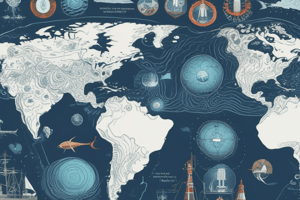Podcast
Questions and Answers
Kādi ir trīs galvenie okeānu veidi?
Kādi ir trīs galvenie okeānu veidi?
Pasaule, Atlantijas un Klusais okeāns.
Kādas ir divas svarīgas funkcijas, ko okeāni veic Zemes sistēmā?
Kādas ir divas svarīgas funkcijas, ko okeāni veic Zemes sistēmā?
Regulē klimatu un nodrošina dzīvesvietu daudziem dzīvniekiem.
Ko nozīmē termins 'okeāna straumes'?
Ko nozīmē termins 'okeāna straumes'?
Tas nozīmē ūdens plūsmu, kas virzās caur okeāniem.
Kāds ir atšķirības starp ezeru un okeānu?
Kāds ir atšķirības starp ezeru un okeānu?
Kādām dzīvības formām okeānā ir vislielākā nozīme?
Kādām dzīvības formām okeānā ir vislielākā nozīme?
Flashcards
Okeāns
Okeāns
Liels sāļūdens ūdenstilpnes
Sāļūdens
Sāļūdens
Ūdens ar izšķīdušām sāļām
Okeāna dzīvnieki
Okeāna dzīvnieki
Dzīvnieki, kas dzīvo okeānā
Jūras straumes
Jūras straumes
Signup and view all the flashcards
Okeāna dibena reljefs
Okeāna dibena reljefs
Signup and view all the flashcards
Study Notes
Ocean Properties
- Oceans cover about 71% of Earth's surface, a vast expanse of saltwater.
- Ocean water is salty due to dissolved minerals and salts, which come from rocks and minerals on land.
- The salinity of ocean water varies depending on factors such as the input of freshwater from rivers and rain.
- Ocean water has unique physical properties: density, temperature, and pressure.
- Ocean temperature varies with depth and latitude. The sun warms the surface water, but the deeper you go, the colder the water gets.
- Ocean currents move warm and cold water around the globe, influencing weather patterns and climate.
- Salinity also affects the density of water, impacting ocean currents.
- Waves, tides, and currents are essential parts of the ocean environment, shaping coastlines and affecting marine life.
Ocean Zones
- The ocean can be divided into different zones based on depth and light penetration.
- The intertidal zone is the area where the ocean meets the land, alternately covered and uncovered by tides. Organisms here must adapt to dramatic changes in moisture and temperature.
- The neritic zone, extends from the low tide line to the edge of the continental shelf. It has relatively shallow water and abundant sunlight, supporting a variety of marine life, including fish and algae.
- The oceanic zone is the open ocean beyond the continental shelf. It has deeper water and less light, supporting organisms adapted to this environment like deeper-living fishes and large marine mammals.
- The benthic zone includes the ocean floor, supporting organisms adapted to the lack of light and high pressure.
Ocean Life
- Marine ecosystems are diverse and abundant, with an array of organisms suited to the ocean's different zones.
- Phytoplankton and algae form the base of many food webs in the ocean.
- Zooplankton feed on phytoplankton and serve as food for larger animals.
- Many types of fish, mammals, reptiles, and invertebrates inhabit the ocean in various depths and locations.
- Whales, dolphins, seals, and sea turtles are large marine mammals found in the ocean.
- Coral reefs are complex ecosystems with diverse marine life that are particularly sensitive to changes in the ocean environment.
- The ocean plays a vital role in regulating the Earth's climate.
- Coastal areas and the oceans are sensitive to pollution and human activity, particularly from the dumping of waste and chemicals.
Ocean Currents
- Ocean currents are large-scale movements of water that occur throughout the ocean.
- These currents can be driven by wind, temperature differences, and salinity gradients.
- Currents transport warm and cold water around the globe, which influences weather patterns and climate.
- Ocean currents play a vital role in distributing nutrients and oxygen throughout the marine ecosystem, influencing abundance and distribution of marine populations.
- Some currents are warm, bringing heat from low latitudes to higher latitudes.
- Some are cold, transporting cold water to the warmer areas.
Human Impact on the Ocean
- Human activities significantly impact ocean health.
- Pollution from industrial waste, agricultural runoff, and plastic waste affects marine life.
- Overfishing depletes fish populations and disrupts marine ecosystems.
- Climate change causes ocean acidification, warming, and sea level rise, threatening marine species and habitats.
- Ocean exploration can provide vital information about ocean life, currents, and resources.
- Responsible management of ocean resources, such as sustainable fishing practices and reduced pollution, is essential for the health of the oceans and the planet.
Studying That Suits You
Use AI to generate personalized quizzes and flashcards to suit your learning preferences.




